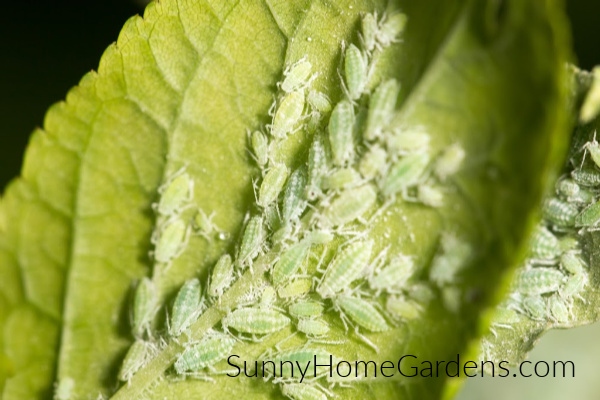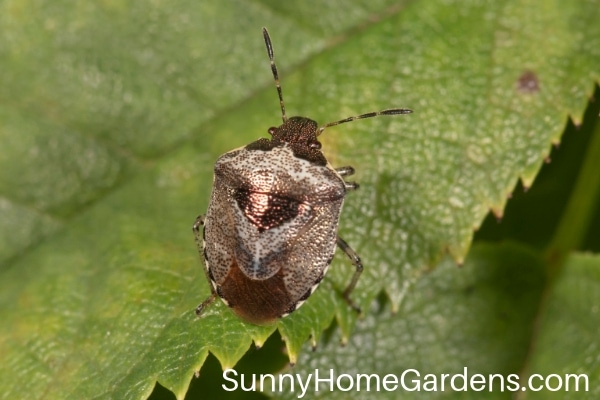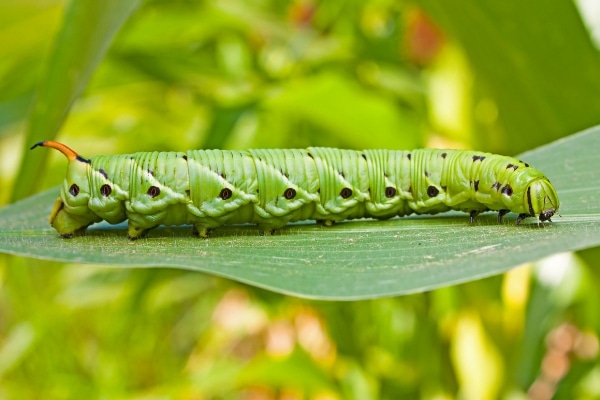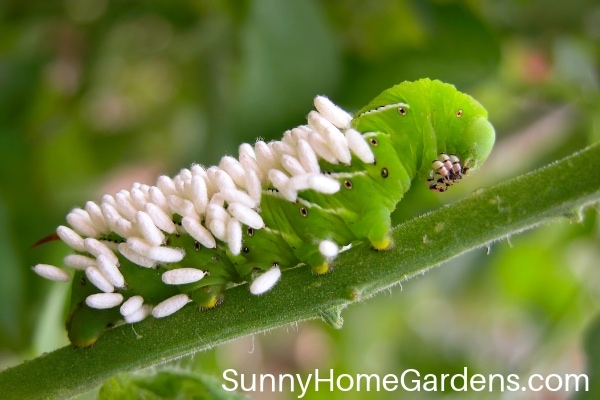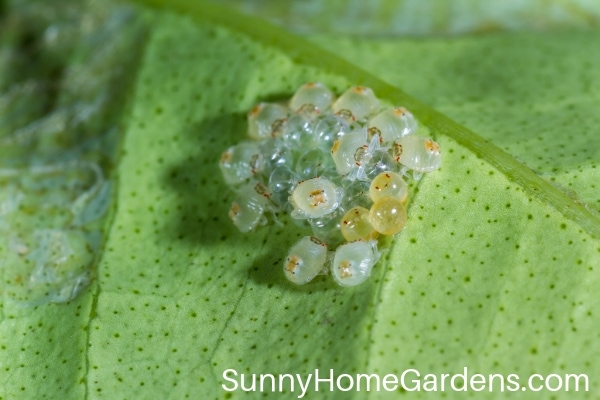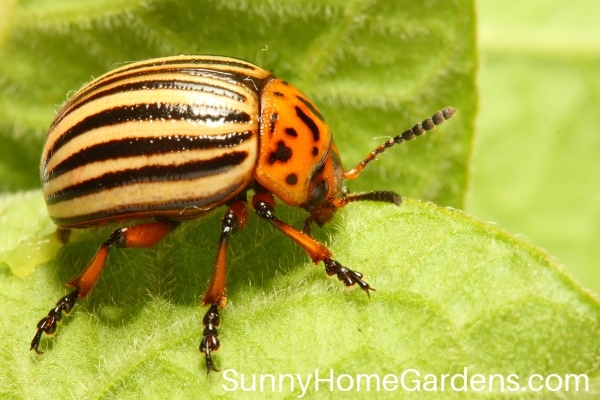The last thing you want after you’ve spent your time and effort growing tomato plants is for some garden pests to eat your plants!
As a gardener, you are probably used to dealing with several different creepy crawlies! The tomato pests to be aware of and make sure to protect your tomato plants from are aphids, stink bugs (those buggers are everywhere around here!), tomato fruit worms, cutworms, hornworms, Colorado potato beetle, and spider mites.
These creatures don’t all create the same amount of damage to your tomato plants. It helps knowing what you are dealing with for each one.
I’ve included information about each pest, signs on your tomato plant that will tell you which pest you are dealing with as well as beneficial insects, companion planting and other natural and organic ways to rid your tomato plants of these pests.
Table of Contents
Tomato Plant Pests
Aphids
Aphids are tiny green or black insects and some have wings.
Signs of Aphids on Tomato Plants
Some signs and symptoms that your tomato plants are having an infestation with aphids is the plant leaves will curl and they can also turn yellow. You might find your tomato plant’s growth is stunted as well.
You’ll notice your plants are infested with aphids by checking out the bottom of the tomato leaves or on your tomato plant stems. You’ll notice small white, green, or black bugs there.
Beneficial Insects
Beneficial insects to help control aphids include both the lacewing larvae, syrphid flies, and ladybugs. They both eat aphids.
Did you know one ladybug can eat 5,000 aphids in its lifetime?
Companion Planting
There are several ways to keep aphids at bay. One of those is to companion plant. This means you will plant other plants near your tomato plants that repel certain bugs. For tomato plant aphid control consider planting mint, garlic, chives, petunias, anise, and coriander near your tomato plants.
Other Methods
Other ways you can get rid of aphids are to hose them down each day. You would just take a hose and spray all the aphids off the tomato plant.
You can use aluminum foils to repel the aphids. How you do this is use aluminum foil as a mulch around your tomato plant. I’ve heard this confuses the aphids and they are driven away by it.
There are several homemade aphid sprays you can use. One recipe is
1/3 Cup Distilled White Vinegar
1 Cup Water
Add this to a spray bottle. Spray your tomato plant with it and it kills both the aphids and the larvae.
Stink Bugs
I don’t know if you have stink bugs where you live, but we’ve always had them. During certain parts of the summer, huge swarms of them will attach to our house.
If you smash a stink bug the odor isn’t good.
Stink bugs are brown, black or green and may or may not have markings. They have what looks like a shield on their back.
Signs of Stink Bugs on Tomatoes
Your tomato plants will weaken from stink bugs. The young tomatoes may not form correctly either.
You might also find that ripened tomatoes have yellow-white spots beneath the surface.
When they attack your tomatoes, your plants are weakened and young fruit may form improperly as a result. Yellow-white spots beneath the skin of ripened fruit are a common sign of stink bug damage to your crops.
Beneficial Insects
The stink bug is an insect that came here from China and doesn’t have any beneficial insects that are in the US that eat or otherwise deter them.
Companion Planting
If you want to do some companion planting to repel stinkbugs consider planting radish near your tomato plants.
Other Methods
The most common way of getting rid of stink bugs is to remove them and smash them. Most people wear gloves when they do this.
RELATED: How to Easily Save Your Own Tomato Seeds
RELATED: Rhubarb Plant Care
Tomato FruitWorms
Tomato fruitworms are also known as the corn earworm. They are in shades of pink, green, yellow, black or brown and have a light striping on them. Tomato fruitworms grow to almost 2 inches long.
Signs of Tomato Fruitworms
These guys are moth larvae. The moths bore into green tomatoes, close to the stem and leave holes in the tomatoes. They hatch a little over a week later. These large holes in your tomatoes let you know that the tomato fruitworm is the problem pest you are dealing with.
Natural Enemies of the Tomato Fruitworm
Some natural enemies of the tomato fruitworm include bats, toads, birds and spiders. You can try to attract these to your yard.
Companion Planting
Soybeans, borage, geraniums, thyme, and marigolds are all said to deter tomato fruitworms
Other Methods
Other methods of getting rid of the tomato fruitworm include handpicking the tomato fruitworm and dropping them into a bucket with soapy water.
Hornworms
Hornworms look like large, green caterpillars with a horn on their rear end. They can get huge – about 5-6″ long!
Signs You Have Tomato Hornworms
If you are seeing spotty and chewed leaves on your tomato plant as well as the tomato fruit you probably have a tomato hornworm problem.
If you look closely you might be able to see the green poop the hornworms leave behind on top of your tomato plant leaves. Make sure to check under the leaves for the hornworm.
Beneficial Insects
Beneficial insects that are great if you have a hornworm problem include braconid wasps, ladybugs and lacewings.
The ladybugs and the lacewings feed on the hornworm eggs.
The braconid wasps lay their eggs on the hornworm. When their eggs hatch, the larvae eat the hornworm. The hornworm can still live with this going on for a little bit, but they do die from the larvae eating them.
Attracting birds that like to eat caterpillars is another great way to deal with hornworms.
Companion Planting
Some great plants for repelling the tomato hornworm are basil, marigolds, sage, mint, and borage.
Other Methods
Starting at the beginning of summer check over your tomato plants looking for the tomato hornworm. Handpick any that you see. You can put them in a bucket with warm soapy water. Do this every other week.
Spider Mites
Spider mites are in the arachnid family and are really small. If you are looking for spider mites, bring a magnifying glass out with you.
Signs you Have Spider Mites
Spider mites go under the tomato plant leaves and they suck out the plant juices.
Some of the signs you have a spider mite problem are seeing small, light-colored dots on your tomato leaves. Your tomato leaves might also turn yellow and curl up.
If your spider mite infestation is severe the leaves of your tomato plants will be covered in webbing.
Beneficial Insects
The beneficial insects that are great at helping keep spider mites under control include ladybugs, lacewings, and predatory mites.
Companion Planting
Some plants known to repel spider mites include onion, garlic, cloves, and chives.
Other Methods
Other methods for controlling spider mites include using a hose that has a strong stream of water to wash under tomato leaves off. This is make the spider bites fall off the leaves.
Spider mites are attracted to dust, so make sure to spray down your tomato plants if they get dusty.
If you want to create a spray to help reduce spider bites you can try this one:
SPIDER MITE SPRAY:
1/2 cup buttermilk
4 cups wheat flour
5 gallons water
Mix these all together and then spray where you have spider mites.
RELATED: Planting Garlic Bulbs
RELATED: How to Plant Jalapeno Peppers
Colorado Potato Beetle
The Colorado potato beetle is a small oval beetles that is yellow/orange with black stripes. As far as bugs go.
Signs Your Tomato Plants have Colorado Potato Beetles on Them
The Colorado potato beetles and their larvae are pretty easy to see. You can find the seeds under the leaves.
They will eat the leaves (plus the stalk!) of your tomato plants.
Natural Predators of the Colorado Potato Bug
Some of the natural predators of the Colorado potato bug include ladybugs, ground beetles, small wasps, and toads.
Companion Planting to Repel the Colorado Potato Bug
If you want to plant some plants to help repel these bugs try planting green beans, coriander, naturtium, horseradish, flax, marigold and garlic.
Other Methods
You can use a neem oil spray to help with your Colorado potato bug problem.
Other ways are to use row covers, try using a deep hay or straw mulch as well as handpicking the beetles and larvae off your tomato plants.
General Organic Tomato Pest Control Solutions
If you ever see these pests on your tomato plants make sure to take action immediately.
Spraying down your tomato plants, especially under their leaves to remove the pests is a great first action. Doing this several days in a row can make a huge impact on these pests.
After doing this, here are the next steps – please note we spoke about many of these above.
1. Hand picking – grab a pair of gloves, fill a bucket with some soapy water. Then pull the pests off the tomato plant and drop them into the bucket.
2. Plant debris – make sure the area around your tomato plants are free from any plant debris or weeds. This can help get rid of habitats the tomato plant pests like to live in.
3. Organic insecticidal soap – mix with water to create a 2 to 3% solution and apply directly to common tomato pests for best results.
4. Neem oil – this organic, plant-based oil is very effective against aphids, stink bugs and tomato fruit worms. You can find it in many garden centers or order it online. Apply according to package directions for best results.
5. Beneficial insects – introduce beneficial insects, such as ladybugs, praying mantis, and lacewings (all available for order online) to your garden and let them do what they do best.
Garden pests are unfortunately part of life for tomato gardeners.
If you prepare your garden ahead of time with certain companion plants and the right resources you can take the steps to minimize the damage from tomato pests.


